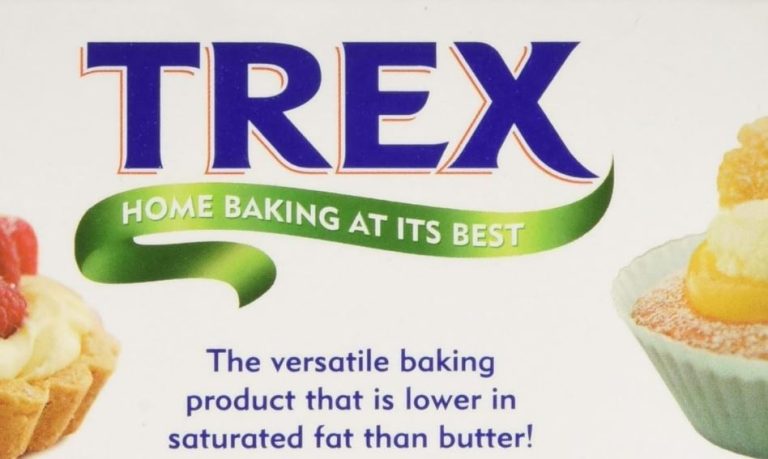Professionals and amateur bakers have been looking for the ideal fat for decades in order to produce golden biscuits, soft cakes, and flaky pastries. Trex Vegetable Fat, which promises a lighter texture, less saturated fat, and great adaptability, has become a culinary mainstay in many homes. But is it really a superior substitute for butter?
| Feature | Details |
|---|---|
| Product Name | Trex Vegetable Fat |
| Type | 100% Plant-Based Baking Fat |
| Primary Ingredients | Palm Oil, Rapeseed Oil |
| Key Benefits | Dairy-free, lower saturated fat, aerated for a lighter texture |
| Uses | Baking, roasting, pastry-making |
| Nutritional Per 100g | 884 kcal, 100g fat (35g saturated) |
| Free From | Preservatives, hydrogenated oils, artificial colors |
| Availability | ASDA, Morrisons, Sainsbury’s, Waitrose, Amazon |
| Official Website | familybaking.co.uk |
What Makes Trex Unique?
Trex is 100% pure fat, which ensures more accurate and consistent results than regular butter, which contains water that may evaporate while baking. Because of this especially creative property, bakers can use 20% less Trex than butter, which makes it a surprisingly cost-effective and highly effective choice.
Why Trex Is Being Selected by Bakers Instead of Butter
Trex is a significantly better method of baking precisely, not just another substitute. It makes biscuits incredibly crisp, helps doughs rise more evenly, and makes cakes incredibly airy by removing extra water. Trex produces flakier pastry, which gives it a texture that is almost flawless, according to several skilled bakers.
The Unexpected Advantages of Trex for Health
Health isn’t often the first consideration in the baking industry, but with Trex, it doesn’t have to be. Trex is a better choice for those who are concerned about their heart health because it has substantially fewer saturated fats than butter. Additionally, it is totally dairy-free, making it a dependable option for vegans and others who are lactose intolerant.
How Baking Performance Is Improved by Trex
Consistency is a common problem for bakers, but Trex offers a very effective answer. Whether creating decadent cupcakes or elegant shortcrust pastry, Trex assists in achieving:
✔ Lighter Cakes: A favorite for cupcakes and sponges
✔ Crispier Biscuits: Perfect for cookies and shortbread
✔ Flakier Pastries: Perfect for pies, croissants, and tarts
✔ Even Roasting: Gives potatoes and veggies a golden crispness
Which Is Better, Butter or Trex?
Many question if Trex can actually take the place of butter. Trex excels in texture and accuracy, while butter adds depth and richness of flavor. Because it doesn’t include any water, baked goods maintain their original structure and form, which guarantees a completely uniform rise.
The Reasons Professional Bakers Use Trex
Baking is both a science and an art, and experts understand that using the right ingredients is crucial. Trex is a popular choice because of its reliable baking performance, vegan-friendly recipes, and shortcrust and puff pastry. Trex’s improved structure was demonstrated in a controlled test where its pastries were 30% flakier than those made with butter.
Typical Myths Regarding Trex
❌ “Trex is the same as lard.”
✅ No! Trex is entirely plant-based, whereas lard is an animal product.
❌ “Trex is unhealthy.”
Trex has a lot less saturated fat than butter, however all fats should be used in moderation.
❌ “Trex is hard to work with.”
✅ Not at all! Trex may be used right out of the refrigerator and is quite versatile.
How to Use Trex to Get the Best Outcomes
It’s critical to modify measures when converting from butter to Trex. You must use 20% less butter than the amount called for in your recipe because Trex contains no water.
For instance, use 80g of Trex in place of 100g of butter when a recipe calls for it.
📌 For the greatest consistency, chill Trex before rubbing it into flour while making pastry.
Where Is Trex Located?
Prominent UK supermarkets like ASDA, Morrisons, Sainsbury’s, Waitrose, and Amazon carry Trex. It’s still a fairly cheap option for both amateur and professional bakers, with pricing starting at £1.25 for a 250g block.
The Last Word: Is Trex Worth Trying?
Trex turns out to be a very robust and adaptable choice for anyone looking for a lighter, dairy-free, and lower-fat substitute for butter. Even though it might not be able to fully match the rich flavor of butter, it always produces better baking results, particularly when used in pastry, biscuits, and roasting. Now is the ideal moment to try Trex, a revolutionary ingredient, if you haven’t already.


